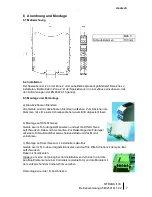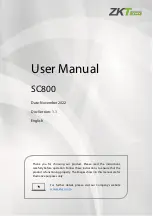
english
SITRANS I100
14
Operating instruction A5E02591611-02
5.3 Engineering of the power dissipation in cabinets
When electronic devices are integrated in cabinets free air movement is restricted and the
temperature rises. To minimise the temperature rise it is important to optimise the power
dissipation as well as the elimination of the produced heat inside a cabinet.
a) Natural Convection in closed cabinets
•
Application: when the dissipated power is moderate and when the system operates in a
dusty or harsh environment
•
Calculation of the maximum allowed power dissipation:
Pmax =
∆∆∆∆
t * S * K
P
max
[W]
max. allowed power dissipation in the cabinet
∆
t [°C]
max. allowed temperature rise
S [m²]
free, heat emitting surface of the cabinet
K [(W/m²*°C)]
thermal emitting coefficient (K=5.5 for painted steel sheets)
The calculated value for P
max
has to be smaller than the total average power dissipation
(70 % of max. power dissipation) of the installed isolators: Pmax <
∑
P
70%
b) Natural convection in open cabinets
•
Function: the heat is removed by cool air flowing through the devices
•
Requirements:
- inlet and outlet ports in the lower and upper ends of the cabinet
- the air flow path must be kept free from obstacles.
•
Result: Depending on the engineering the improvement can reach a two times higher
power dissipation as with a)
c) Forced ventilation with heat exchanger in closed cabinets
•
Application: when either the harsh environment or the high dissipated power do not
allow natural convection
•
Function: a heat exchanger with a fan pulls the air into the cabinet and pushes it into the
heat exchanger plates that are cooled by the external ambient air moved by a second
fan.
•
Result: Depending on the engineering the improvement can reach a 5 or 6 times
higher power dissipation as with a)
d) Forced ventilation in open cabinets
•
Function: the filtered air is taken from the bottom cabinet openings by one or more fans,
flows through the devices, and finally exits at the top of the cabinet.
•
Calculation of the required air flow:
Q = (3.1 * P
70%
) /
∆∆∆∆
t
Q [m³/h]
required air flow
P
70%
[W]
dissipated power (70 % of max. power dissipation)
∆
t [°C]
allowed temperature rise in the cabinet
e) Air conditioned cabinets
•
Application: for hot climates - it is possible to reach a cabinet temperature equal or even
lower than the ambient temperature
•
Function: a specific refrigerating system or the existing air conditioning system can be
used for cabinet conditioning










































